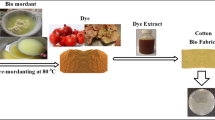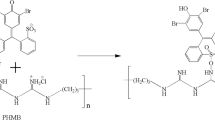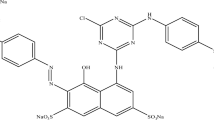Abstract
Nowadays, there is less emphasis on the aesthetic traits of textiles and more on their functionality. Traditionally functional textiles are prepared in two steps including dyeing and then finishing. This adds extra cost to the process through more energy consumption and water effluent. Current research deals with a single bath application of antibacterial finish with reactive dyeing. L-cysteine (L-cys) is a natural defensive thiolated amino acid found in many living organisms and is applied to cotton fabric through simple conventional reactive dyeing method. Fabrics with L-cys were assessed against both Escherichia Coli and Staphylococcus Aureus strains and promising results were found containing antibacterial activity up to 20 washes. The fastness properties of antimicrobial dyed fabrics were unaffected when compared with control samples. However, shade depth (k/s) was decreased with increasing amount of antibacterial agent while control samples showed highest value. This proposed process reduces chemical- and energy consumption, as well as water effluent.
Graphical abstract















Similar content being viewed by others
References
Alebeid OK, Zhao T (2016) Simultaneous dyeing and functional finishing of cotton fabric using reactive dyes doped with TiO2 nano-sol. J Text Inst 107:625–635
Alihosseini F, Sun G (2011) 17—antibacterial colorants for textiles. In: Sun G, Pan N (eds) Functional textiles for improved performance, protection and health. Woodhead Publishing, Cambridge. https://doi.org/10.1533/9780857092878.376
Caldeira E, Piskin E, Granadeiro L, Silva F, Gouveia IC (2013) Biofunctionalization of cellulosic fibres with l-cysteine: assessment of antibacterial properties and mechanism of action against Staphylococcus aureus and Klebsiella pneumoniae. J Biotechnol 168:426–435
Chun DT, Gamble GR (2007) Using the reactive dye method to attach antibacterial compounds to cotton. In: 2007 Beltwide cotton conferences, New Orleans, Louisiana, pp 1242–1246
Eren HA, Anis P, Davulcu A (2009) Enzymatic one-bath desizing—bleaching—dyeing process for cotton fabrics. Text Res J 79:1091–1098. https://doi.org/10.1177/0040517508099388
Farouk R, Gaffer H (2013) Simultaneous dyeing and antibacterial finishing for cotton cellulose using a new reactive dye. Carbohydr Polym 97:138–142
Gohl EPG, Vilensky LD (1983) Textile science. CBS Publishers and Distributors, Delhi
Gouveia IC (2010) Nanobiotechnology: a new strategy to develop non-toxic antimicrobial textiles current research, technology and education topics in applied microbiology and microbial biotechnology. Formatex Badajoz 150:407–414
Gouveia IC, Sá D, Henriques M (2012) Functionalization of wool with l-cysteine: process characterization and assessment of antimicrobial activity and cytotoxicity. J Appl Polym Sci 124:1352–1358. https://doi.org/10.1002/app.34587
Haque ANMA, Hannan M, Rana MM (2015) Compatibility analysis of reactive dyes by exhaustion-fixation and adsorption isotherm on knitted cotton fabric. Fash Text 2:1–12
Hou A, Sun G (2013) Multifunctional finishing of cotton fabrics with 3,3′,4,4′-benzophenone tetracarboxylic dianhydride: reaction mechanism. Carbohyd Polym 95:768–772. https://doi.org/10.1016/j.carbpol.2013.02.027
Ibrahim NA, Gouda M, Husseiny SM, El-Gamal AR, Mahrous F (2009) UV-protecting and antibacterial finishing of cotton knits. J Appl Polym Sci 112:3589–3596. https://doi.org/10.1002/app.29669
Kim T-K, Son Y-A (2005) Effect of reactive anionic agent on dyeing of cellulosic fibers with a Berberine colorant—part 2: anionic agent treatment and antimicrobial activity of a Berberine dyeing. Dyes Pigm 64:85–89
Kim S, Choi JE, Choi J, Chung K-H, Park K, Yi J, Ryu D-Y (2009) Oxidative stress-dependent toxicity of silver nanoparticles in human hepatoma cells. Toxicol Vitro 23:1076–1084
Martins AF, Pereira AG, Fajardo AR, Rubira AF, Muniz EC (2011) Characterization of polyelectrolytes complexes based on N, N, N-trimethyl chitosan/heparin prepared at different pH conditions. Carbohydr Polym 86:1266–1272
Martins AF, Bueno PV, Almeida EA, Rodrigues FH, Rubira AF, Muniz EC (2013) Characterization of N-trimethyl chitosan/alginate complexes and curcumin release. Int J Biol Macromol 57:174–184
Martins AF, Facchi SP, Follmann HD, Pereira AG, Rubira AF, Muniz EC (2014) Antimicrobial activity of chitosan derivatives containing N-quaternized moieties in its backbone: a review. Int J Mol Sci 15:20800–20832
Nelson DL, Lehninger AL, Cox MM (2008) Lehninger principles of biochemistry. W. H. Freeman, New York
Pan N, Sun G (2011) Functional textiles for improved performance, protection and health. Elsevier, Amsterdam
Schindler WD, Hauser PJ (2004) Chemical finishing of textiles. Elsevier, Amsterdam
Shore J (1995) Cellulosics dyeing. Soc Dye Colour, p 189
Umbreen S, Ali S, Hussain T, Nawaz R (2008) Dyeing properties of natural dyes extracted from turmeric and their comparison with reactive dyeing. Res J Text Appar 12:1–11
Author information
Authors and Affiliations
Corresponding authors
Rights and permissions
About this article
Cite this article
Rehman, A., Rehman, A., Khalid, W. et al. Simultaneous dyeing and anti-bacterial finishing on 100% cotton fabric: process establishment and characterization. Cellulose 25, 5405–5414 (2018). https://doi.org/10.1007/s10570-018-1934-9
Received:
Accepted:
Published:
Issue Date:
DOI: https://doi.org/10.1007/s10570-018-1934-9




